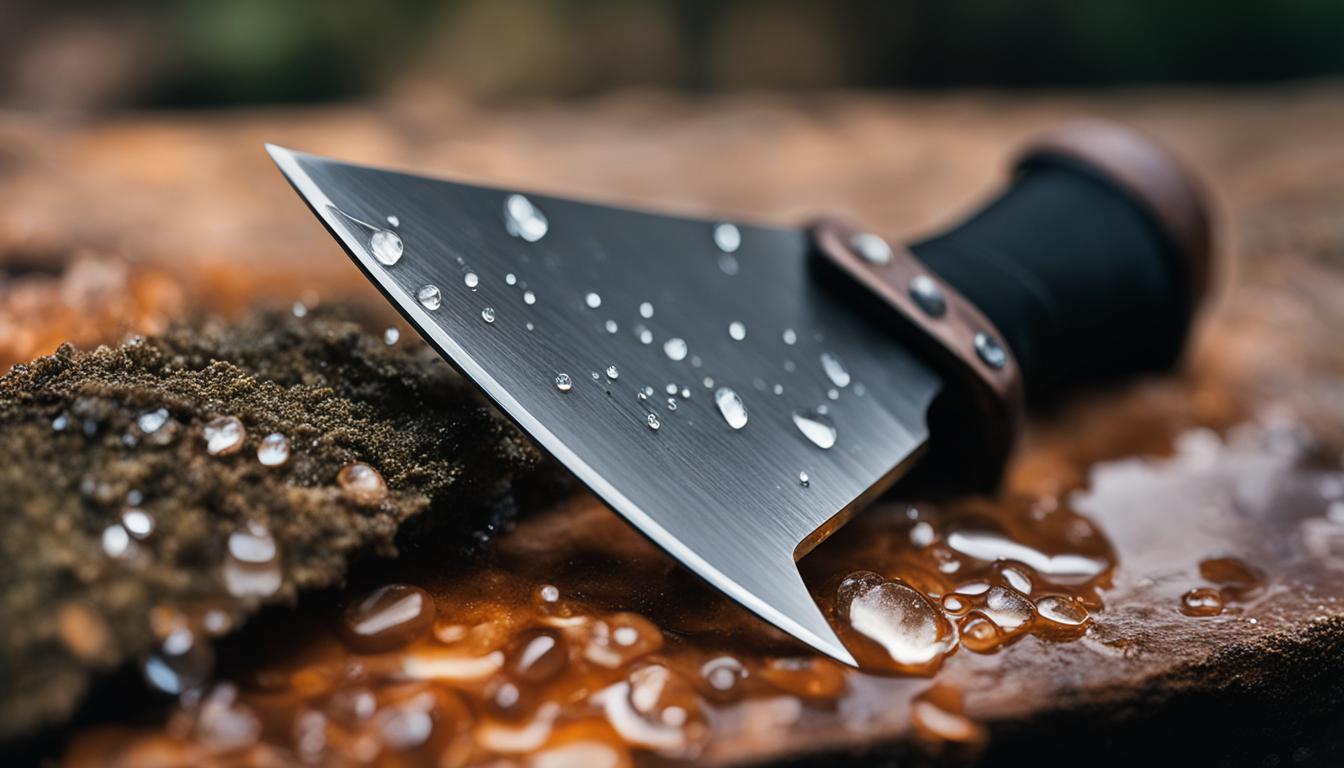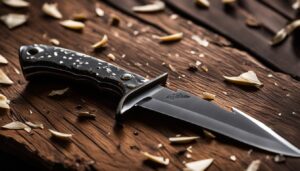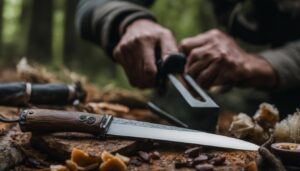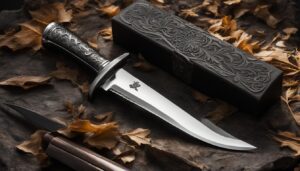Learning how to sharpen a hunting knife is an important skill for any outdoor enthusiast. In this article, I will guide you through the step-by-step process of two sharpening methods: using a traditional sharpening stone and using sandpaper and a mousepad. These techniques will help you enhance the sharpness and cutting ability of your hunting knife, ensuring that it is always ready for your next adventure.
Key Takeaways:
- Sharpening your hunting knife at home is a valuable skill for outdoor enthusiasts.
- Two effective sharpening methods are using a traditional sharpening stone and using sandpaper and a mousepad.
- Proper care and maintenance are essential for preserving the sharpness of your hunting knife.
- Regular steeling helps maintain a straight and sharp edge.
- With practice and attention to detail, you can achieve a razor-sharp hunting knife edge.
The Traditional Sharpening Stone Method
When it comes to sharpening a hunting knife, the traditional sharpening stone method is a tried and true technique. Using a sharpening stone not only enhances the sharpness of the blade but also allows you to maintain control over the sharpening angle. Here’s a step-by-step guide to mastering this method:
Step 1: Prepare the Stone
Start by submerging the sharpening stone in water. This prevents the stone from clogging up with metal shavings during the sharpening process. Let the stone soak for a few minutes before moving on to the next step.
Step 2: Color the Bevel
Using a marker, color the sharpening bevel of the knife. This will help you keep track of the contact between the stone and the edge as you sharpen. It serves as a visual indicator of your progress and ensures that you maintain a consistent angle throughout the sharpening process.
Step 3: Sharpen at the Correct Angle
Hold the knife at a 20-degree angle to the stone. This is the optimal angle for sharpening most hunting knives. Make light passes on the stone, checking the marker wear to ensure that you maintain the correct angle. Consistency is key to achieving a sharp and reliable edge.
Step 4: Raise a Burr and Refine the Edge
Make alternating passes on both sides of the bevel to raise a burr. A burr is a tiny flap of metal that indicates the edge has been properly sharpened. Once the burr is raised, refine the edge by making additional passes on the stone, gradually decreasing the pressure. This step will further enhance the sharpness of the blade.
The traditional sharpening stone method requires practice and patience, but with time, you can master this technique and keep your hunting knife sharp and ready for any outdoor adventure.
| Benefits of the Traditional Sharpening Stone Method | Drawbacks of the Traditional Sharpening Stone Method |
|---|---|
|
|
The Sandpaper and Mousepad Method
When it comes to sharpening your hunting knife, the sandpaper and mousepad method offers a simpler and effective approach. This technique allows for the creation of a convex edge, resulting in a razor-sharp blade that is perfect for various outdoor tasks.
To begin, you will need to create a sharpening board using sandpaper glued to a piece of wood. It is recommended to use wet/dry sandpaper ranging from 320 to at least 1000 grit for effective sharpening. The coarsest grit will help remove any nicks or imperfections on the blade, while progressively finer grits will refine the edge.
Before starting the sharpening process, it is essential to color the edge bevel with a marker. This will provide better visibility and allow you to monitor the progress of the sharpening. Holding the knife at an angle, make consistent passes on the sandpaper, ensuring that the entire edge comes into contact with the abrasive surface. Start with the coarsest grit and gradually progress to finer grits to achieve the desired sharpness.
After raising a burr on both sides of the blade, it is important to remove it completely by honing the edge on the finest grit. This will provide the final polish and refinement, resulting in a razor-sharp convex edge. To further enhance the sharpness, stropping the knife on a piece of leather with jeweler’s rouge can be done for the ultimate finishing touch.
Benefits of the Sandpaper and Mousepad Method
- Simple and effective technique for sharpening hunting knives
- Allows for the creation of a convex edge, enhancing cutting performance
- Cost-effective alternative to traditional sharpening methods
- Provides control and visibility during the sharpening process
- Easy to maintain and replicate the sharpening angle
Sharpening your hunting knife using the sandpaper and mousepad method offers a versatile and efficient way to ensure your blade is always ready for action. With the right technique and a bit of practice, you can achieve a razor-sharp convex edge that will enhance your outdoor experience.
Essential Tools for Knife Sharpening
When it comes to sharpening your hunting knife, having the right tools can make all the difference. Here are some essential items you’ll need to achieve a razor-sharp edge:
- Traditional Sharpening Stone: A medium natural Arkansas stone is ideal for the traditional sharpening method. It provides excellent sharpening capabilities and durability.
- Wet/Dry Sandpaper: Ranging from 320 to at least 1000 grit, the sandpaper is essential for the sandpaper and mousepad method. It allows you to gradually refine the edge of your knife.
- Mousepad: The mousepad serves as a cushioning surface for the sandpaper, providing stability while sharpening.
- Scrap of Wood with Glue: You’ll need a piece of wood with sandpaper glued to it to create a sharpening board for the sandpaper method.
- Marker: A marker can be used to color the edge bevel of your knife, allowing you to easily track your progress during sharpening.
These tools are readily available and will help you achieve the sharpness and cutting performance you desire for your hunting knife. Investing in quality sharpening tools is a worthwhile endeavor for any outdoor enthusiast.
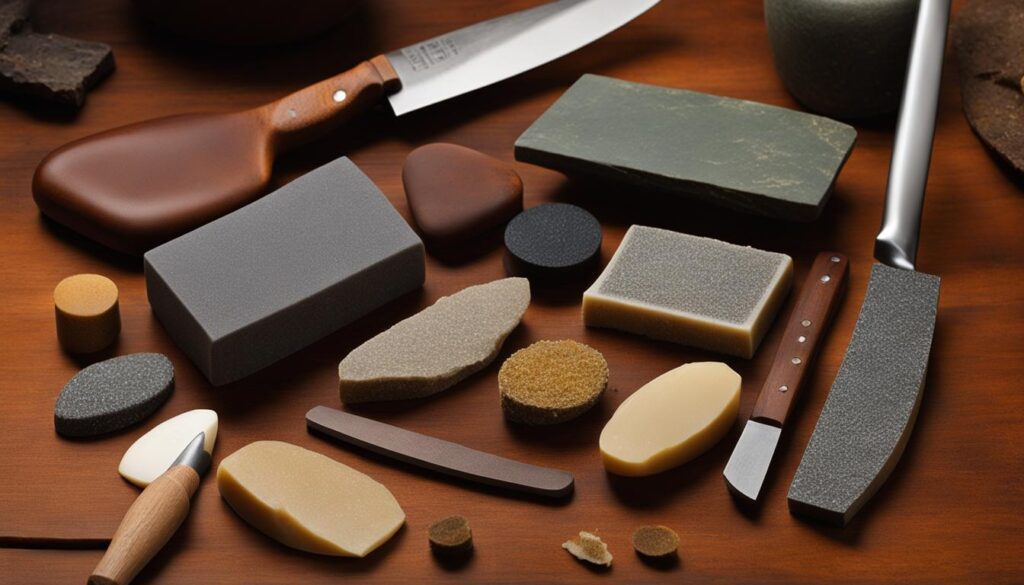
Table: Essential Tools for Knife Sharpening
| Tool | Description |
|---|---|
| Traditional Sharpening Stone | A medium natural Arkansas stone is ideal for the traditional sharpening method. It provides excellent sharpening capabilities and durability. |
| Wet/Dry Sandpaper | Ranging from 320 to at least 1000 grit, the sandpaper is essential for the sandpaper and mousepad method. It allows you to gradually refine the edge of your knife. |
| Mousepad | The mousepad serves as a cushioning surface for the sandpaper, providing stability while sharpening. |
| Scrap of Wood with Glue | You’ll need a piece of wood with sandpaper glued to it to create a sharpening board for the sandpaper method. |
| Marker | A marker can be used to color the edge bevel of your knife, allowing you to easily track your progress during sharpening. |
Tips for Successful Knife Sharpening
When it comes to sharpening your hunting knife, there are a few key tips to keep in mind to achieve optimal results. Maintaining a consistent angle during sharpening is crucial for creating a sharp and durable edge. Using an angle guide can help you achieve this consistency by ensuring that you hold the knife at the correct angle every time.
Another important aspect of successful knife sharpening is the formation of a burr. A burr is a tiny flap of metal that is created when sharpening, indicating that the desired level of sharpness has been achieved. To form a burr, make alternating passes on each side of the bevel, applying light pressure to gradually raise the burr.
It’s also worth noting that knife sharpening is a skill that requires practice. As you sharpen your hunting knife, pay attention to the feedback from the blade. If the knife feels dull or doesn’t cut as smoothly as desired, it may be necessary to revisit the sharpening process and make adjustments.
Key Tips for Successful Knife Sharpening:
- Use an angle guide to maintain a consistent sharpening angle.
- Make alternating passes on each side of the bevel to form a burr.
- Pay attention to the feedback from the blade and adjust as needed.
Quote:
“Sharpening a knife is a delicate process that requires attention to detail. By following these tips, you can achieve a razor-sharp edge that will enhance your hunting experience.” – Knife Sharpening Expert
By following these tips and techniques, you can master the art of knife sharpening and ensure that your hunting knife always has a sharp and reliable edge. Remember to practice regularly, maintain a consistent angle, and pay attention to the feedback from the blade. With time and experience, you’ll be able to sharpen your hunting knife with confidence and precision.
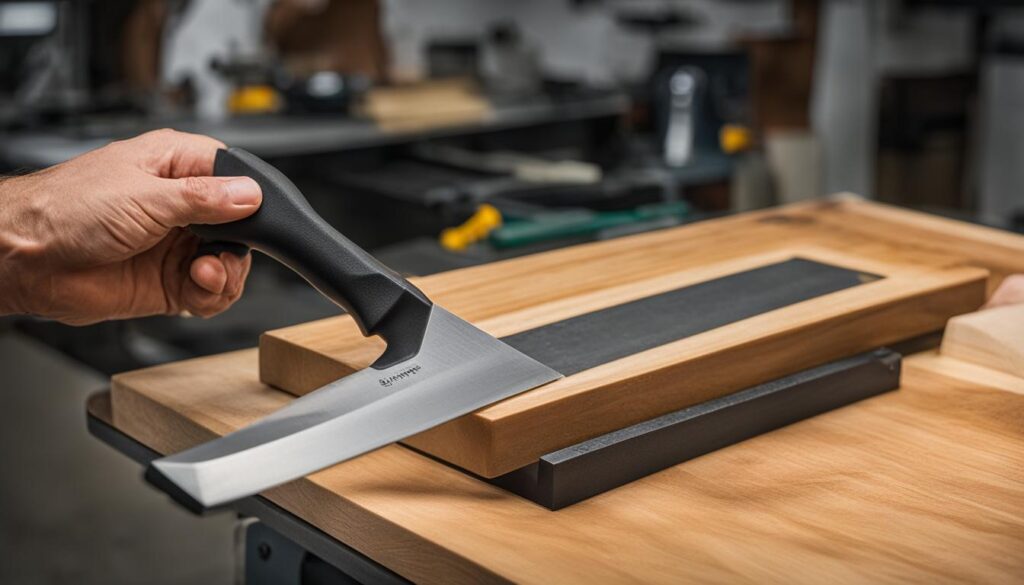

Care and Maintenance of a Sharpened Knife
Proper care and maintenance are essential for preserving the sharpness and longevity of your hunting knife. By following these knife care tips, you can ensure that your blade remains in optimal condition for all your outdoor adventures.
Blade Protection
One of the most important aspects of knife care is protecting the blade from rust and damage. After sharpening your hunting knife, apply a thin coat of lubricant, such as Ballistol, to the entire blade. This will help prevent rust and corrosion, especially if you live in a humid climate or frequently use the knife in wet conditions.
It’s important to note that petroleum jelly should be avoided as a blade lubricant, as it can attract moisture and lead to rust formation. Instead, stick to specifically designed knife lubricants for optimal protection.
Preventing Rust
Preventing rust on your hunting knife is crucial for maintaining its performance and appearance. Always dry the blade thoroughly after cutting acidic foods to prevent the acid from corroding the metal. Additionally, avoid using a dishwasher to clean your knife, as the harsh detergents and high temperatures can damage the blade and handle. Instead, wash your knife by hand with mild soap and warm water, then dry it immediately.
Proper Storage
Properly storing your sharpened hunting knife is essential for preventing unnecessary damage and maintaining its sharpness. Store the knife in a knife block or sheath to protect the blade from accidental impacts and to prevent it from coming into contact with other metal objects. If you prefer to store your knife in a drawer, use blade protectors to ensure that the blade remains safe and secure.
By following these care and maintenance practices, you can extend the lifespan of your sharpened hunting knife and ensure that it is always ready for your next outdoor adventure.
The Importance of Steeling
When it comes to maintaining a sharp edge on your hunting knife, steeling plays a crucial role. While it doesn’t actually sharpen the blade, steeling helps straighten the edge, ensuring smooth and precise cutting. By using a steel rod with a finely grooved surface, you can gently realign the knife edge, preserving its performance and extending its lifespan.
Steeling should be done on a regular basis, especially before each use, to keep your knife in optimal condition. To perform this technique effectively, maintain an angle between 20 and 30 degrees and make several passes on each side of the blade. The goal is to restore the edge to its original alignment, resulting in a razor-sharp cutting surface that’s ready for any task.
Regular steeling not only enhances the cutting ability of your knife but also prolongs its overall lifespan. By maintaining a straight edge, you’ll reduce the need for frequent sharpening, which can remove excess metal and shorten the life of your blade. Incorporating this simple maintenance step into your knife care routine will ensure that your hunting knife remains sharp and reliable, ready for your next outdoor adventure.
“Steeling is an essential technique for maintaining a sharp edge on your hunting knife.”
Remember, steeling is not a substitute for sharpening. While steeling helps maintain the edge, it should be supplemented with periodic sharpening using the techniques mentioned in previous sections. A combination of steeling and sharpening will keep your hunting knife in its best shape, ensuring optimal performance and longevity.
| Benefits of Steeling | How Often to Steel |
|---|---|
| 1. Straightens the knife edge | 1. Before each use |
| 2. Enhances cutting ability | 2. After extended use |
| 3. Prolongs knife lifespan | 3. When the blade feels dull |
| 4. Reduces the need for frequent sharpening | 4. When the edge becomes misaligned |
Conclusion
Mastering knife sharpening techniques is essential for proper hunting knife maintenance and longevity. By employing the right methods and tools, you can ensure your hunting knife remains sharp and ready for any adventure. Remember to maintain a consistent angle and raise a burr to achieve a razor-sharp edge.
However, maintaining a sharp knife goes beyond sharpening. Proper care and maintenance are equally important. Regular steeling, lubrication, and protection from rust will help preserve the sharpness and cutting ability of your hunting knife.
With these knife care tips in mind, you can enhance your outdoor experience by having a reliable, sharp hunting knife by your side. So, don’t overlook the importance of sharpening and maintaining your knife, and gear up for your next outdoor adventure with confidence.
FAQ
Why is learning how to sharpen a hunting knife important?
Sharpening a hunting knife is important because it enhances its cutting ability and ensures it is always ready for use during outdoor adventures.
What are the two sharpening methods discussed in this article?
The two sharpening methods discussed in this article are the traditional sharpening stone method and the sandpaper and mousepad method.
How do I sharpen a hunting knife using a traditional sharpening stone?
To sharpen a hunting knife using a traditional sharpening stone, you need to submerge the stone in water, use a marker to color the sharpening bevel, hold the knife at a 20-degree angle, and make light passes on the stone while maintaining the correct angle.
What is the sandpaper and mousepad method of sharpening a hunting knife?
The sandpaper and mousepad method involves creating a sharpening board using sandpaper glued to a piece of wood. The knife is held at an angle and passed over the sandpaper, starting with coarse grit and progressing to finer grits, to raise a burr and refine the edge.
What tools do I need for sharpening a hunting knife?
For sharpening a hunting knife, you will need a traditional sharpening stone, wet/dry sandpaper ranging from 320 to at least 1000 grit, a mousepad, and a piece of wood with glue to create a sharpening board.
How can I ensure a successful knife sharpening?
To ensure a successful knife sharpening, it is important to maintain a consistent sharpening angle, raise a burr on both sides of the bevel, and practice alternating passes on the stone or sandpaper to refine the edge.
How should I care for and maintain a sharpened hunting knife?
To care for and maintain a sharpened hunting knife, it is important to keep the blade well-oiled with a thin coat of lubricant, avoid exposing it to moisture and acidic foods, and store it properly to prevent unnecessary damage.
What is the purpose of steeling a hunting knife?
Steeling a hunting knife does not sharpen the blade but rather straightens its edge, ensuring a smooth and even cutting experience. Regular steeling helps maintain the knife’s performance.
